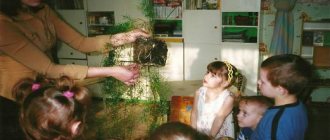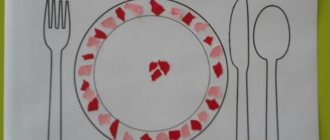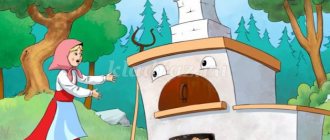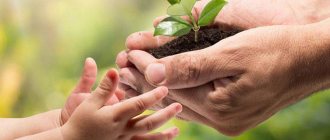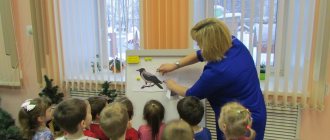Young ecologist. Environmental education program in kindergarten
Explanatory note
Existing programs for kindergarten contain a section for introducing children to the outside world, within the framework of which preschoolers learn about nature: the diversity of plants, animals, seasonal phenomena, human activities in nature. The program material guides the teacher towards developing in children a humane attitude towards living beings and developing skills in caring for the inhabitants of a corner of nature. In general, the positive trends of the programs are currently insufficient for the implementation of the general strategy of continuous environmental education, for laying the foundations of environmental culture and environmental consciousness.
The aggravation of the environmental problem in the country dictates the need for intensive educational work to develop environmental consciousness and a culture of environmental management among the population. This work begins in kindergarten - the first link in the lifelong education system.
Preschool childhood is the initial stage of the formation of a person’s personality and his value orientation in the world around him. During this period, a positive attitude towards nature, towards the “man-made world”, towards oneself and towards the people around them is formed.
The main content of environmental education is the formation in a child of a consciously correct attitude towards natural phenomena and objects that surround him and with which he becomes acquainted in preschool childhood.
Children's consciously correct attitude towards nature is based on its sensory perception, emotional attitude towards it and knowledge of the characteristics of life, growth and development of individual living beings, some biocenoses, knowledge of the adaptive dependencies of the existence of living organisms on environmental factors, relationships within natural communities. Such knowledge in the process of a child’s communication with nature provides him with an understanding of specific situations in the behavior of animals, the state of plants, their correct assessment and adequate response. The conscious nature of the relationship is manifested in the fact that children can explain the situation themselves or understand the explanations of adults; they can independently or together with adults, understanding the situation and knowing the needs of a living being, perform individual labor actions aimed at preserving and improving the life of plants and animals.
The process of developing a consciously correct attitude towards nature is accompanied by certain forms of child behavior, which can serve as a criterion for assessing the level of his environmental education. These are independent observations, conducting experiments, asking questions, the desire to talk about experiences and impressions, discuss them, embody them in various activities (reflect in a game, create art products, care for animals and plants).
The program contains seven sections. The first section is basic information about the universe, the inanimate nature of the Earth and its significance in the life of living beings. The next two are devoted to revealing the relationship of plants and animals with their environment. The fourth traces the role of habitat in the process of ontogenesis - the growth and development of individual species of plants and higher animals. The fifth reveals relationships within communities whose lives children can observe. Subsections marked with an asterisk are not necessary to study with children; they can be useful to the teacher as additional material. The sixth section shows different forms of human interaction with nature. The first point, which considers the needs of people (children) as living beings and the ensuing requirements for the environment, is of particular (health) importance. The seventh section provides general recommendations for the distribution of material by age.
The “Young Ecologist” program can be used in any preschool institution where there is a transition from traditional familiarization with nature to solving issues of environmental education for preschoolers. The program deliberately does not strictly link the tasks and content of environmental education to a particular age, which makes it possible to begin its implementation in any age group of kindergarten. The recommendations given in the program for the distribution of material by age allow the teacher to take an individual approach to children, adjusting at each stage the volume and depth of solving the assigned tasks. In all sections of the program, the “attitude” position is given, which will help the teacher understand how much the children accepted and learned new knowledge.
Program “We are earthlings” (author N. Veresova)
The program is one of the attempts to implement the ideas of a humanitarian approach to ecology in the practice of preschool education.
The main goal of the program is to create conditions for the formation of the foundations of environmental awareness among older preschoolers. The author believes that the basis of consciousness is the value relationship of personal meanings. Ecos - home, logos - science, meaning. Treating home as an unconditional value, and in connection with this, understanding one’s place and role in the world, realizing one’s responsibility for it - this is precisely what should resonate in the soul of every child.
Objectives of the program: 1) providing conditions for the development of semantic positions, the most important of which is the position of an earthling, heir, zealous owner and defender of his home - the Earth; 2) creative self-expression of the child and teacher. Culture has accumulated not only a system of values—meanings—but also means of expressing them. During classes, the child and the adult discover and gradually master these means (through play, fairy tales, painting, folklore) and begin to use them, creating small masterpieces (riddles, poems, drawings, etc.); 3) development of the child’s abilities. This problem is solved through the use in the program of ideas of forming concepts based on meaningful generalizations (V.V. Davydov); 4) enriching children with knowledge from various fields of science, technology, literature and art.
The program has a number of features:
- playful character. Classes are not conducted in the form of a game, but are spontaneous and free play for the child and the teacher. The game is created collaboratively, not always according to a pre-planned plan or scenario. Not to teach by playing, but to build play as a way of education - this is the special role of the teacher;
— openness. Children and teachers cannot help but change its content in accordance with individual levels. It is impossible to love and cherish abstractions;
— variability. The proposed lesson notes are “worked out” options, tested and proven to be effective. But this is a script, and what the play will be like depends on the teacher and the children.
And yet, the author believes, in order for the lesson to remain holistic, the invariant basis of the program must be preserved. It contains two components: a) content - basic environmental concepts and semantic positions revealed in this lesson. The system of these concepts contains the internal logic of the program itself, the violation of which reduces its potential; b) technological invariant consists in constructing a program based on psychological patterns of development, the formation of consciousness [1, pp. 140-143].
Analysis of complex programs:
Development program
The “Development” program, developed by a team of child psychologists, is aimed at developing the intellectual and artistic abilities of preschoolers, which are understood as indicative actions with imaginative means of solving problems. Developed abilities help the child to independently navigate new situations, find the necessary solutions, and have a meaningful attitude towards his own activities. Based on the sensory abilities formed in early preschool age, the ability for visual modeling develops in middle and older preschool age. Familiarization with nature, included in the “Development” program, is one of the means of developing children’s different abilities and does not pose the task of their environmental education. Children learn the simplest forms of symbolic reflection of natural objects, their condition, changes, and relationships. The program has an educational tendency towards environmental education of preschool children [5].
Program "Childhood"
In the “Childhood” program, created at the St. Petersburg State Pedagogical University, the section “A child discovers the world of nature” involves a thorough acquaintance of children with a wide variety of phenomena from the life of plants, animals, and their communities.
The program material (for each age) includes four content blocks:
The first is information about plants and animals as representatives of wildlife; children learn the features of the external structure and vital functions of the body (nutrition, breathing, etc.), the connections of living beings with their environment, their uniqueness are revealed to them.
The second block reveals to children the mechanisms of adaptive relationships between living organisms and their environment; children become familiar with the properties of various environments in detail, they form an idea of groups of animals living in a homogeneous environment.
The third block is knowledge about the growth, development and reproduction of plants and animals familiar to children; children gain an understanding of the sequential changes in organisms and the cyclical nature of the process.
The fourth block is knowledge of an ecosystem nature; children get acquainted with plants and animals living in the same community and their interdependence. Children will also learn that a person can influence communities of living organisms in different ways - he can destroy them, or he can support them.
Thus, “Childhood” is a program not only for the enriched multifaceted development of a preschooler’s personality, it is a comprehensive program with an environmental bias, providing the child with both comprehensive development and the formation of the initial stage of an ecological worldview. This combination can contribute in the future (subject to continuity of environmental education) to the development of full-fledged environmental consciousness, which will determine the activities of an adult in everyday life, on vacation and at work [5; p. 119].
"Origins" program
“Origins” is another comprehensive program created by the psychological and pedagogical team of researchers named after. A.V. Zaporozhets. The authors consider it as a basic program aimed at the comprehensive, full development of the child, the formation of universal (including creative) abilities in him in accordance with the level of age capabilities and the requirements of modern society. The program is based on the concept of psychological age as a stage in the development of the human personality, characterized by the special relationship of a child with an adult; a certain hierarchy of activities; psychological achievements of the child, which are evidence of the development of his psyche, consciousness and personality. The authors distinguish two psychological ages in the preschool period: younger - 3-5 years and older - 5-7 years. At each age there is a main genetic task of development, which predetermines the type of leading activity. It is activity that is the factor that develops the psyche, therefore the main task of education comes down to organizing various types of activities and developing the child’s communication with adults and peers at each age, which determines the assimilation of universal human values.
In general, we can say that the “Origins” program, interesting in many respects, has not reached the modern level of full-fledged environmental education - it does not set the task of developing in children the principles of an ecological culture that considers nature as a value in all aspects of human development - cognitive, aesthetic , moral and physical. The program has important sections - health, museum pedagogy, artistic creativity, historical and geographical ideas, etc., but they are not related to the section “Nature and the Child”, and therefore do not allow the formation of a comprehensive understanding of nature and human interaction with it, cannot create a holistic picture of the world in which man and nature are connected by strong ties. The principle of child development through activity stated in the program is not sufficiently implemented; knowledge of nature, communication with it, reflection of it in the art and creativity of children involve many different types of activities that can be included in the pedagogical process [5].
“Krokha” program
“Krokha” is a program for educating the youngest (young children) in the family and kindergarten. E. F. Terentyeva (author of the program section) highlights a number of circumstances that adults can use to introduce children to nature. If there are plants, animals, or animals in the room (at home or in kindergarten), adults can attract children to observations and joint care, evoke in them an emotional response to the beauty and various manifestations of living beings. The whole world opens up to children from the window of the room - an adult can show a child a lot. Walking can also be used for environmental education. The author gives recommendations on what and how you can observe with children in different seasons, how to play with them in nature and with natural materials [5].
Rainbow program
In the “Rainbow” program, “The World of Nature” (a subsection of the program) is a component of the cognitive development of children, within which they are given information, develop cognitive processes, form an attitude towards the world around them, which creates in children an image of the world, a holistic view of the environment. The methodological material of the program contains a significant number of lessons about plants, animals, planet Earth and the structure of the solar system. Children are given a lot of geographical knowledge and exotic information (about the nature of Africa, about dinosaurs, etc.), based on seasonal observations, “portraits” of each month are compiled, children are introduced to the history of watches, calendars, and globes. Preschoolers receive a lot of interesting knowledge, but not enough environmental knowledge. Children learn to contemplate nature, to respond emotionally to its state, but it is also important to comprehend what they see, to understand what it means. The program includes educationally attractive facts about the world and nature, but they cannot provide children with an understanding of the nature directly surrounding the child or develop a value-based attitude towards it. The frequent use of the verbal method—the teacher’s story, explanation instead of observations—cannot contribute to this either [5].
